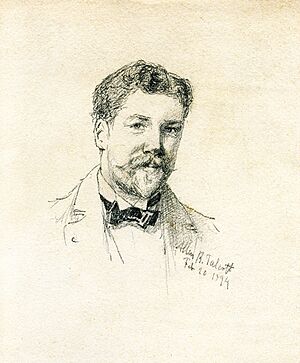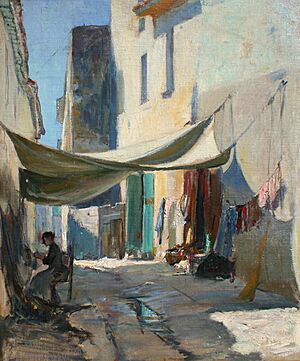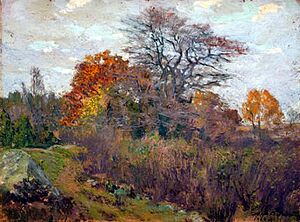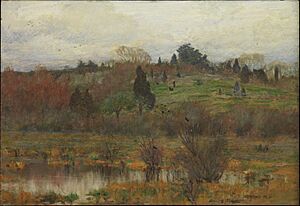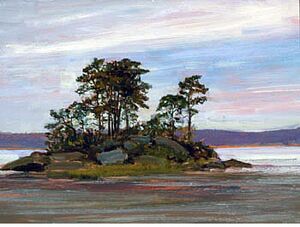Allen Butler Talcott facts for kids
Allen Butler Talcott (born April 8, 1867 – died June 1, 1908) was an American artist. He was famous for painting beautiful landscapes. He studied art in Paris for three years. When he came back to the United States, he joined the Old Lyme Art Colony in Connecticut. This was a special group of artists.
Allen Talcott often painted outdoors, a style called en plein air. His art usually showed nature scenes. His paintings often used styles like Barbizon and Tonalism. Sometimes, he also added ideas from Impressionism. He was especially good at painting trees. He spent eight summers painting in Old Lyme before he passed away at 41.
Contents
Allen Talcott's Early Life and School
Allen Butler Talcott was born on April 8, 1867. His family lived in Hartford, Connecticut. He showed a talent for art from a young age. He would draw pictures of his teachers and friends in his school books.
He went to Trinity College in Hartford. He graduated in 1890. After college, he started his art training. He studied at the Hartford Art Society. His teacher there was a painter named Dwight William Tryon.
Later, he moved to New York City. He studied briefly at the Art Students League of New York. Then, he went to Paris, France, for three years. He studied at a famous art school called Académie Julian. His teachers were Jean-Paul Laurens and Benjamin Constant. While in France, his paintings were shown in big art shows. These were called the Paris Salons in 1893 and 1894.
Allen Talcott's Art Career
In 1897, Talcott lived in Arles, France. He rented the house where famous artist Vincent van Gogh once lived. He shared it with another artist, Frank DuMond. After this, Talcott returned to Hartford. He set up his own art studio there.
He also went back to New York City. He joined a shared studio space. This space was started by Henry Ward Ranger. Ranger became a good friend and influenced Talcott's art. Ranger also started the Old Lyme Art Colony in Connecticut. Talcott was one of the first artists to join this group.
In 1901, he first stayed at Florence Griswold's boarding house in Old Lyme. This house later became an art museum. Talcott worked in his New York studio during winters. But he spent his summers in Old Lyme for eight years. He stayed there until he died in 1908.
During this time, Barbizon art was popular in the U.S. Ranger and other Old Lyme artists developed a style called Tonalism. This style used only a few soft, muted colors. Talcott also liked French Impressionism. He saw American Impressionism in Connecticut in the late 1890s. Artists like Childe Hassam were developing this style.
However, Ranger and Tryon influenced Talcott more. So, his early paintings were mostly Barbizon and Tonalist. They showed landscapes in shades of brown, green, and gold.
In 1903, Talcott bought a home in Old Lyme. It had a view of the Connecticut River. Around this time, Hassam brought Impressionism to the art colony. Many artists, including Talcott, started to use some Impressionist ideas.
Talcott didn't fully switch to Impressionism. Instead, he mixed parts of it into his Tonalist paintings. He kept his interest in using a few main colors. But he also focused on how light looked, like Impressionists did. He made his colors lighter than Ranger's. His brushstrokes also changed, becoming more "flickery."
Talcott mainly painted landscapes. These often showed scenes around Old Lyme and the Connecticut River. He especially loved painting trees. He was known for how well he painted them. Another artist, Charles Vezin, said Talcott knew a lot about nature. He added that no one was better at painting trees than Talcott. Talcott liked to paint en plein air, which means outdoors. He made oil sketches on wood panels. These sketches were often so good they were seen as finished paintings. People admired them for their lively feel and rich textures.
A critic from The New York Times reviewed Talcott's art in 1991. They said he was "more talented than many of his friends who became famous for Impressionism."
Allen Talcott's Family Life
In 1905, Allen Talcott married Katherine Nash Agnew. She was the daughter of a doctor from New York. They had a son named Agnew.
Talcott's uncles, John Butler Talcott and James Talcott, helped him with his art. They had started the American Hosiery Company. John Butler Talcott also helped create the New Britain Museum of American Art. This museum has several of Allen Talcott's paintings.
Allen Butler Talcott's nephew, Dudley Talcott, also became an artist. He was a sculptor, writer, and illustrator.
Allen Talcott passed away at his summer home in Old Lyme on June 1, 1908. He was 41 years old and died from a heart attack.
Where to See His Art
Talcott had only one solo art show during his life. It was at Kraushaar Galleries in 1907. A review in The New York Times said he was good at showing the structure of a landscape. He also had a great sense of color.
Talcott's art was shown regularly in many places. These included the National Academy of Design and the Pennsylvania Academy of Fine Arts. He also showed his work at the Wadsworth Atheneum and the Carnegie Institute. He won a silver medal in 1904 at the St. Louis Exposition. He also won a medal at the Portland Exposition.
Today, you can see his paintings in many museums. These include the Metropolitan Museum of Art and the Florence Griswold Museum. His art is also at the Mattatuck Museum and the New Britain Museum of American Art. He was a member of the Salmagundi Club and the Lotos Club. Some of his work is in the Lotos Club's collection.
Gallery
See Also
- List of American painters


